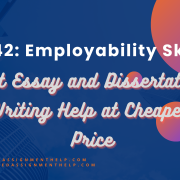Detailed Assessment Brief:
In this module you are required to demonstrate your learning across all of the module learning outcomes by producing a 1500 word assignment exploring the factors impacting on the health of a family (refer to the summative assessment case studies provided in the module Canvas tile). The summative assessment has been planned to help you demonstrate the knowledge and understanding required at level 3 to meet the module learning outcomes. All module learning outcomes must be met to pass the module.
Learning outcomes:
- LO1 Identify the main factors that may affect the health and well-being of individuals, communities and populations.
- LO2 Present and explain information regarding health inequalities drawing on a range of evidence.
- LO3 Summarise the potential impact of poor health on the individual.
Word limit for your assignment:
The word limit for this assignment is 1500 words with a 10% tolerance. This means that your overall word count must be between 1350 words and 1650 words. Do not exceed 1650 words. If your submitted work is more than 10% above the word limit then the work will be marked and a penalty applied. The word count excludes your front sheet, references and any appendices but includes headings, quotations and the use of citations (reference cited) in the body of your work.
Presentation of your work:
- Ensure that you include a front sheet with the following information; your student number, module code, module title, assignment title, module leader, module iteration leader, submission due date and word count. A template of a front sheet is available for you to download and use within the module Canvas tile.
- Use Ariel font, size 12 and 1.5 line spacing.
- Justify your text
- Ensure that your pages are numbered and that your student number is also on every page.
- Please address all sections of the assessment requirements.
Assignment Guidance
Summative Assessment Case Studies:
Refer to the module Canvas tile to access and read the case studies that have been provided for your summative assessment (these can be downloaded for you to print off and read).
Out of the case studies provided, choose only one case study to focus on for your summative assessment. Select one case study of your choice and read through this case study carefully. Think about how the module content taught during the course of the module relates to your chosen case study.
You are not required to re-write your chosen case study within your assignment. You can refer to key information within your chosen case study within your assignment to help you develop your discussion points.
Content of your assignment:
The following guidance has been put together to help you think about the content of your assignment. You are advised to follow the structure outlined in this assessment guidance to help you plan the structure of your assignment and address the statements identified in part 1, part 2 and part 3 of this guidance as these link to the module learning outcomes.
Introduction (Approx. 100 words)
Good introductions give the reader a clear indication of what the assignment is about. In your introduction tell the reader what you aim to cover in the assignment.
- Set out the focus of your assignment i.e. ‘this assignment will discuss…….
- Outline how you intend to address the learning outcomes.
- Indicate which case study you have chosen to focus on.
- Write in the third person i.e. ‘This assignment will…’
- When setting out your aims it is helpful to indicate the order in which these are addressed in the main body i.e. ‘this assignment will first…this will be followed by…Thirdly this assignment will.
PART 1. Identify the main factors that may affect the health and wellbeing of the individuals /communities/population in your chosen case study (LO1). As a guide you may wish to use 450 words for this section.
In this section:
- Make sure that you identify the main factors affecting the health and wellbeing of the family in your case study and the health and wellbeing of the wider community and population.
- Make sure that you support your discussion points with references from appropriate sources of evidence.
To help you develop your ideas for this section, consider the following:
- Consider what health and wellbeing means to individuals.
- Consider a broader definition of health not just physical health i.e. social model of health.
- You could include a definition for health determinants/social determinants.
- Consider the determinants of health in relation to your chosen case study.
- Consider the dimensions of health such as the physical, emotional, social, spiritual and psychological determinants of health in relation to your chosen case study.
PART 2: Drawing on a range of evidence, present and explain how health inequalities might impact on the individuals within your chosen case study (LO2). As a guide you may wish to use 450 words for this section.
In this section:
- Make sure that you explain how health inequalities might impact on the individuals within your chosen case study.
- Make sure that you support your discussion points with a range of sources of evidence.
To help you develop your ideas for this section, consider the following;
- Consider a definition for health inequalities.
- Identify factors linked to health inequalities and how these may impact on the individuals in your case study. You could include issues such as social class, poverty, ethnicity, gender, socio economic status, protected characteristics, vulnerable groups and geographical location.
- Identify national policies that addresses the health inequalities/issues raised in your case study i.e Fair Society Healthy Lives, Marmot Report, and Black Report.
PART 3: Summarise the potential impact of poor health on an individual in your chosen case study
(LO3). As a guide you may wish to use 400 words.
In this section:
- Make sure that you identify one individual from your chosen case study.
- Make sure that you summarise the potential impact of poor health on that individual.
- Support your discussion points with references from appropriate sources of evidence.
To help you develop your ideas for this section, consider the following:
- Consider the causes of poor health i.e. you may wish to link between poverty and health and positive health behaviours, health risk behaviours.
- Consider aspects of the Health Belief Model and how this might relate to your chosen individual.
Conclusion (Approx. 100 words)
- The conclusion should summarise what has been discussed.
- You should not add any new information to your conclusion.
Submission of your assignment:
- This assignment must be written as a Word document and submitted via the 3HW003 Perspective on Health and Wellbeing Canvas topic before 2pm as per your assessment deadline.
- Please ensure that you spell check and proof read your work before submission.
- Always save a copy of your assignment before submission so you have a copy of your work.
- You must ensure that you following the Cite Them Right 2018 Harvard referencing system as adopted by the University of Wolverhampton.
- Submit your work to CANVAS, no paper copies will be accepted or marked. No other form of submission (through the faculty Student office or by e-mail) will be accepted.
Late Submission and Extension Policy:
Refer to the information provided within the Canvas Tile and the University website regarding the Late Submissions and Extension policy.
Important Note:
It is solely the student’s responsibility to ensure that:
- The correct (e.g. latest or final, finished) version of the file is uploaded
- The file submitted is uploaded to the correct Module and assignment link
- The file is in a format that can be opened on University computers, e.g. .doc, .docx, .rtf, .odt – NOT PAGES format.
- The work is submitted on time and not after your submission deadline. You are advised to plan ample time for you to upload and submit your work to ensure that it is submitted on time.
Any file submitted to an incorrect link or in a file format that cannot be opened on a University computer / Canvas will count as a non-submission, even if it has been uploaded before the deadline.











